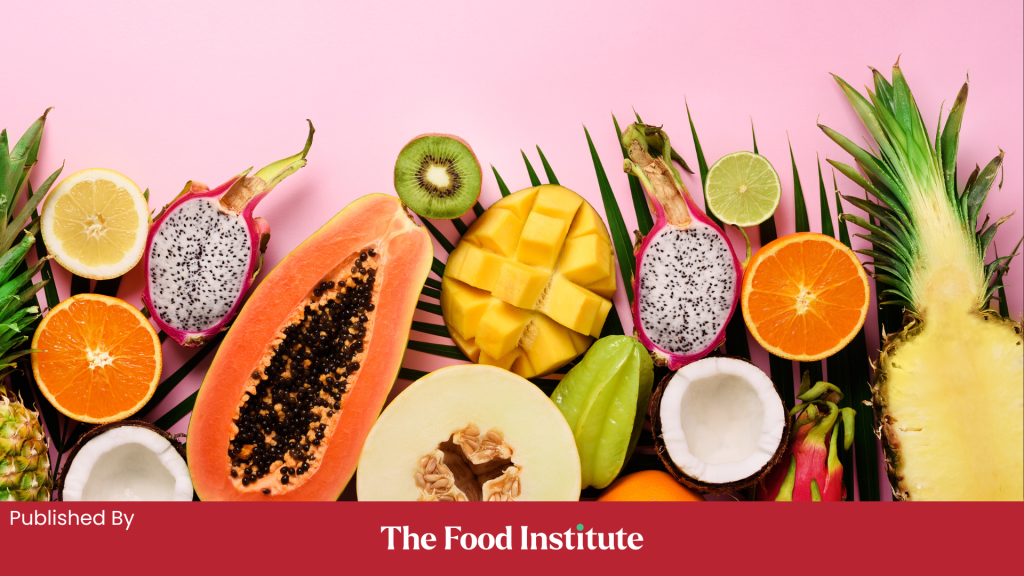On Day 2 of The Food Institute’s Latam Food Week, a new generation was coined: Generation H.
“Think of it as Gen Z meets Hispanic culture,” said Hunter Thurman, president of Alpha-Diver, “a high-sensory, emotion-first approach to eating and drinking.”
Thurman is a known (and trusted) face at The Food Institute, having appeared on several webinars and podcasts in the past detailing his company’s work—the why of different demographics snacking as Alpha-Diver examines the psychological strata behind consumers’ curious choices. Alpha-Diver’s clients include McDonald’s, Coca-Cola, and many more.
On Tuesday, however, Thurman’s focus was at the heart of Latam Food Week with Brian Choi, CEO of The Food Institute, and the many webinar attendees. Here are some brief takeaways.
The Changing Demographics of Consumer Culture
Thurman began with a simple question – how many consumers will identify as Hispanic by 2028?
“Twenty-two percent,” he said, “almost one-quarter of all consumers.”
That is a LOT of dining dinero to spend in retail, foodservice, and more. This year’s U.S. Latino economy continues to grow; it reached $3.2 trillion in 2021 per a new report from the Latino Donor Collaborative as reported by CNBC.
And how many consumers cited Mexican food as their favorite global cuisine, if they had to select just one for the rest of their lives?
“Forty-five percent of Gen Z chose Mexican,” he said. In the year that Cholula surpassed Tabasco as most consumers’ hot sauce of choice and when Modelo Especial usurped Bud Light as the no. 1 beer brand in America, the data tells a much larger story.
But why? Why do people consume the way they do, and what are they gravitating toward? That’s what Alpha-Diver seeks to find out.
Three Driving Forces: Tribal, Experiential, Well-Being
Thurman described three forces that drive most food and beverage purchases.
- Tribal – This product helps me connect with my people (my tribe)
- Experiential – This product offers an experience I’ve never had before
- Well-Being – This product makes me feel better right now
In today’s post-pandemic market of well-being and more holistic nutrition and consumption, it should surprise no one that the third reason people buy what they buy – well-being – far outpaces the other two factors in Alpha-Diver’s consumer research since 2020.
“Consumers are telling us that the world is stressful, and I want to feel better now,” Thurman emphasized, “that’s the macro-driver of the Gen H/Hispanic food and culture zeitgeist.”
Thurman mentioned familiar pairings that are exploding in CPG, retail, restaurant, and even at-home cooking. Acids and sours, spice and heat – these flavors and textures offer more than just a snack. They offer experiences to those who seek them out.
“It’s a dynamic contract,” he said, “in that every bite has many flavors and textures. Szechuan cuisine, popular brands like Dave’s Hot Chicken – there’s a lot of convergence there,” he mentioned, and do the heavy lifting from an emotional and experiential standpoint in the minds (and mouths) of many consumers.
Hispanic Brands on the Rise
Thurman pointed out two brands making headway among much larger and more well-established American mainstays in snacking and beverage. Takis are a Mexican salty snack brand and Electrolit is a functional beverage competing with Gatorade, Powerade, and more. Both, however, are doing gangbusters amid much more fierce competition with larger market share. But why?
“First, the packaging,” Thurman pointed out. The Takis packaging is a neon vortex of swirling flavor and spice, whirling off the package and promising an exciting snacking experience. On the other end of the spectrum, Electrolit offers quite a rational means of understanding its benefits, heavy on hydration and imagery that promises the more fun aspects of a good workout.
“Many consumers want to feel better and counter intuitively reach for brands like Takis, brands that actually trigger a survivalist-type mindset that provides emotional value,” he said. “This is a brand that makes me feel better right now.”
He also pointed out that many Hispanic brands are gaining ground with not only Gen Z but all consumers not because of their south-of-the-border pedigree, but in spite of it. In many ways, marketing that elicits traditional Hispanic values – diversity, flavor, and fun – are outpacing their American-branded counterparts. Electrolit, for example, had a higher rating in Alpha-Diver’s system amid functional beverages than Powerade.
Putting It All Together
“Whether a Latam brand, restaurant, or retail, what comes through in the data is that for Gen H, the opportunity to combine these trends together makes for a strong package and opportunity,” Thurman concluded.
“Don’t overlook the opportunity to combine these trends together,” he added. “Young consumer mindsets are strongly attracted to what makes them feel good fast.”
He ended with a brief comparison of Takis to Cheetos.
“They’re doing very similar jobs in the minds of the consumer,” he said, “as both fulfill that feel-better-now job well. From an equity standpoint, the fact that Takis are from Mexico and Cheetos from Plano is not that important; maybe some of that comes into play, but what our data points to is much more about the experience and the feels than the provenance.”





